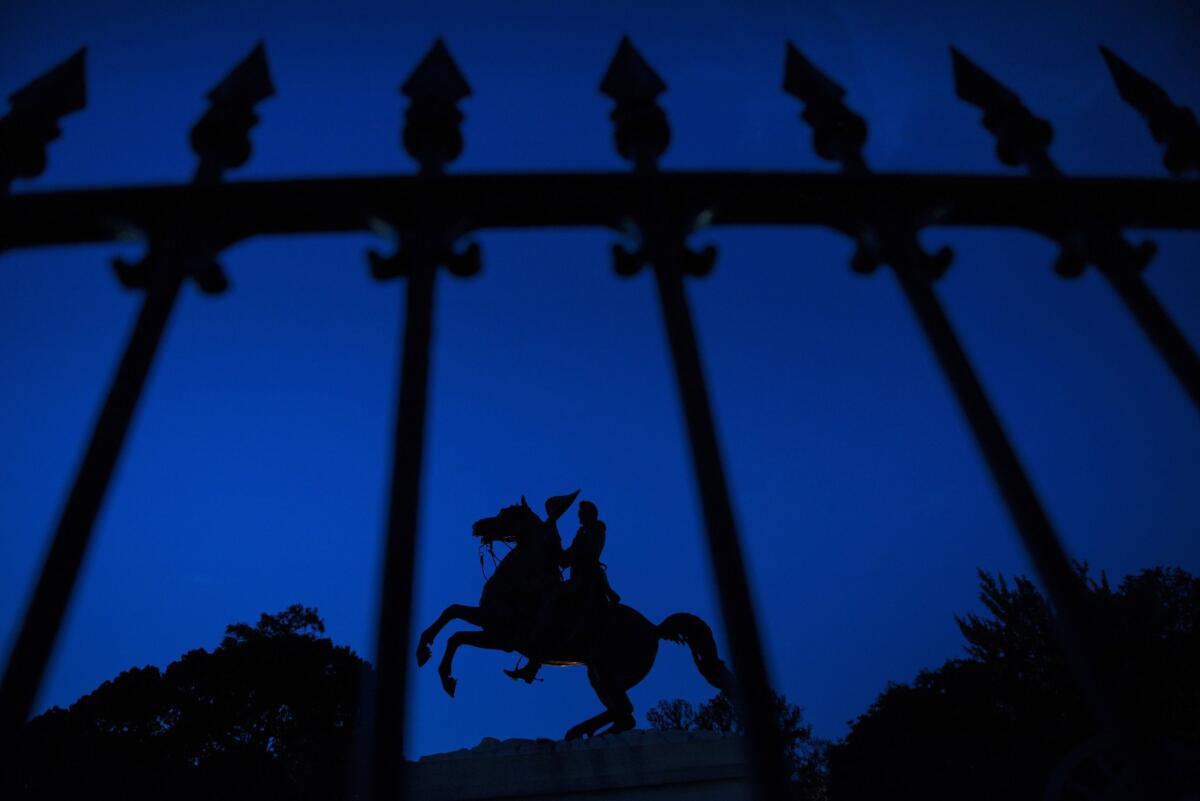Column: Twilight of the hero statues of the Confederacy

Over the past month, popular opinion has settled on the modest conviction that statues of the worst avatars of white supremacy might not merit pride of place in our public squares.
In the past month, more than a dozen hero statues — including John C. Calhoun in Charleston, S.C.; John Breckinridge Castleman in Louisville, Ky.; Raphael Semmes in Mobile, Ala.; and former Philadelphia Mayor Frank “Vote White” Rizzo — have been taken down by government officials.
Each of these statues represents a notorious racist. To put these men on pedestals is to immortalize cruelty and human bondage as not just excusable but heroic.
The statues are mostly banal as art. The one of Rizzo, which was taken down on June 2, makes him look like a misshapen clod in an awkwardly buttoned jacket. Except he’s some 10 feet tall.
Stock hero statues are usually depictions of real people in stone or bronze, from head to toe, at about one-third over life size. They rarely exist because of the vision of an artist. They are more likely beloved objects of particular, even peculiar interest groups.
Michelangelo’s David, a biblical figure in marble, is not a hero statue — its size, symbolism and role in a master’s oeuvre make it more than a mere tribute, undertaken on commission.
The colossus of Lincoln, in the 1922 monument on the National Mall, seated, weary, with a gaze somewhere between prophetic and traumatized, edges toward stock hero status. But its dramatic repurposing by the Rev. Martin Luther King Jr. in 1963 suggested that the story told in the original memorial was far from finished — and set a standard for how memorials might be reinterpreted rather than blindly honored or preserved.
By contrast, statues like the ones of Rizzo and the litany of forgotten Confederate officers deserve only to be relegated to special collections of middlebrow public kitsch, where curators should lay bare the sensibilities that caused these specific men to be cast in metal or carved in stone.
As Jane Dailey, a historian at the University of Chicago, has said, the Confederate statues commemorated nothing when you stop to think about it; instead, they were meant as monuments “toward a white supremacist future.”
As the statues fall, they call into question a particular brand of heroic statuary as a genre, and demand that we view them critically, asking whether the pedestalizing and supersizing of the white male ruling class might express too much racist conquest ideology — and too little art — to let them command our parks and plazas.
Even if most of the hero statues remain standing, we should follow the pigeons: Desecrate them, at least. We must activate our skepticism about the ways dubious heroes are foisted on us.
And we must build new kinds of memorials.
In 1982, the architect Maya Lin honored the troops who died in the Vietnam War with an extraordinary memorial design — glossy black granite walls incised into the landscape and inscribed, as of last year, with 58,276 names. Lin tore down the heroic statue tradition when she refused to put up another one.
Visitors who flock to the Vietnam monument aren’t forced to play along with unnuanced triumphalism. Instead, the wall serves as a place to listen for the voices of the dead.
Still, in 1984, a white sculptor named Frederick Hart was asked to placate militarists with an add-on near Lin’s wall — statues of three armed soldiers. He boasted that he’d put “the folds of those fatigue jackets and pants up against the folds of any medieval angel you can find.” (You can buy replicas in snow globes.)
Lin’s masterpiece is now among the greatest monuments in America; the soldier statues can’t compare.
This week, President Trump threatened to jail anyone who touches the hero statues of his idols, especially the 15-ton Lafayette Square statue of President Andrew Jackson — the notorious ethnic cleanser who owned hundreds of enslaved Black people — astride a rearing, nostrils-flared horse.
Trump has never mentioned the artistry of the piece. He just worships what he knows of Jackson: the imperiousness, the aggression, the white supremacy.
When the statue is removed — and it will be — its specific history deserves a big caption in the museum of fallen men. Jackson’s record as a prolific slave owner and facilitator of the genocide of Native Americans in the 19th century should be kept top of mind. But so should the story of how his hero statue got on its plinth.
Above all, curators should highlight the work of the master craftsman behind the statue: Philip Reid, who almost certainly did the bronze casting and welding.
Reid was enslaved to Clark Mills, the self-trained artist who designed the massive sculpture. Reid and 11 other enslaved Black men built a foundry near Lafayette Square and did the casting for the Jackson statue there.
The Lafayette Square statue is known among sculptors for the technical achievement of its stance: It is supported only on the back legs of Jackson’s horse. The monument is stable because the horse’s legs are made of iron wrapped in bronze, presumably a product in part of Reid’s engineering skills.
Reid later sealed his reputation as a caster and metalworker when he managed — against some odds — to cast and assemble the Statue of Freedom, which crowns the Capitol, just before his own emancipation on April 16, 1862.
The clever ironwork inside Trump’s beloved Jackson statue ensures that it cannot be easily dislodged. But it also guarantees that the seventh president will sink fast when dumped into the Potomac.
More to Read
A cure for the common opinion
Get thought-provoking perspectives with our weekly newsletter.
You may occasionally receive promotional content from the Los Angeles Times.






